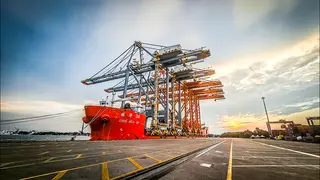Iran’s state-run shipping company, The Islamic Republic of Iran Shipping Line (IRISL), recently started the transfer of Russian goods to India, using a new trade corridor that transits the republic. The route, say experts, grants India easy access to a geography stretching from North Europe, Caucasus to mineral rich Central Asia; bypassing Pakistan.
Opening this 7,200 km long-pending multi-modal transportation corridor via Iran will also boost Russia–India bilateral trade.
The route uses sea, road and rail routes offering the shortest connectivity by linking the Indian Ocean to Caspian Sea via the Persian Gulf. It reduces carriage cost by about 30 per cent and transit time by more than half. Since Russia was sanctioned, Iranian officials were keen to revive the project. The Container Corporation of India and Russian Railways Logistics Joint Stock Company signed a MoU to transport cargo based on a single invoice via the International North-South Transport Corridor (INSTC). An industry expert says, INSTC helps avoid the Suez (sea) route and opens an alternate. “The Suez Canal blockage had held up trade worth $9 billion per day and it has amplified an optimistic outlook to INSTC,” he added.
Strategically important
According to Pritam Banerjee, a trade and logistics expert, for India, the INSTC “trade route is strategically important” and it helps create “opportunities towards resource security” while widening the choice “on value-chain development”. INSTC also involves building a railroad line that can transfer goods arriving at Caspian Sea ports to the south-eastern port of Chabahar, he said.
“So we are improving our sea linkages and using shorter routes while at the same time ensuring better resource security.
India has signed Double Tax Avoidance Agreements and Bilateral Investment Protection Agreements too with some nations, so value chain development can happen with Indian FDI moving into these nations,” Banerjee added.
India Briefing, which publishes FDI-related news, in February said sectors to gain are cross border e-commerce, perishable goods, industrial printers, 3-D printers and robotic assembly accessories.
Pilot-run
Russian cargo consisting of two 40-foot containers having wood laminate sheets, weighing 41 tonnes, departed St. Petersburg for Astrakhan. From Astrakhan, the cargo will cross the Caspian to the northern Iranian port of Anzali and then it will be transferred by road to the southern port of Bandar Abbas on the Persian Gulf. From there it will be loaded onto a ship and sent to JNPT in Maharashtra (the country’s largest container port).
The first attempt to operationalise INSTC was made on June 21, 2021 when the western corridor connected India with Europe and a consignment of 30 containers were sent via train from Vuosaari (which crossed Russia to reach Azerbaijan) and then transported to Bandar Abbas and finally to JNPT. Travel time was 22 days, versus 40 days (via Suez canal).









Comments
Comments have to be in English, and in full sentences. They cannot be abusive or personal. Please abide by our community guidelines for posting your comments.
We have migrated to a new commenting platform. If you are already a registered user of TheHindu Businessline and logged in, you may continue to engage with our articles. If you do not have an account please register and login to post comments. Users can access their older comments by logging into their accounts on Vuukle.